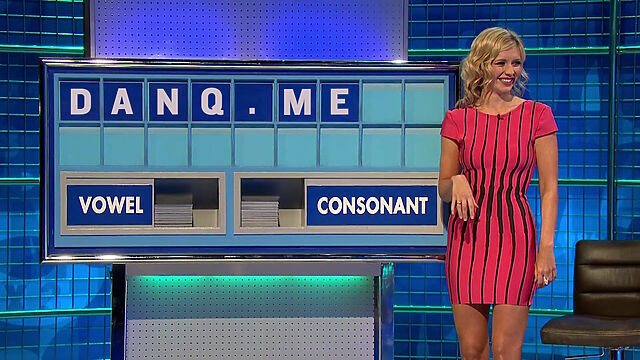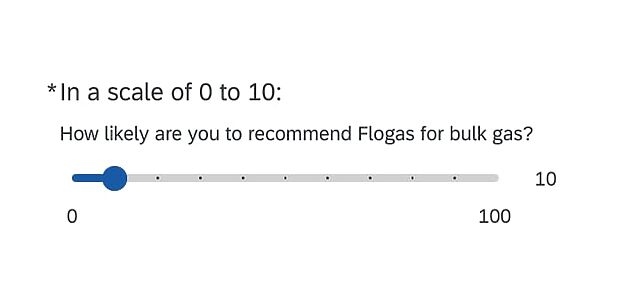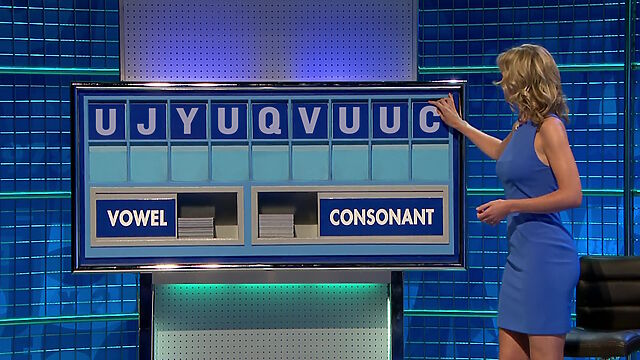Did I just rank my LPG provider 10/10, or 1/10? I genuinely don’t know.
Blog
A Limerick for When You Can’t Be Bothered
Whenever I’m writing a rhyme,
I can’t do the third and fourth line.
Dah-de-da-dah-duh,
Dah-de-de-dah-duh.
But somehow it still works out fine.
Impossible Countdown
Or: Sometimes You Don’t Need a Computer, Just a Brain
I was watching an episode of 8 Out Of 10 Cats Does Countdown the other night1 and I was wondering: what’s the hardest hand you can be dealt in a Countdown letters game?

Sometimes it’s possible to get fixated on a particular way of solving a problem, without having yet fully thought-through it. That’s what happened to me, because the first thing I did was start to write a computer program to solve this question. The program, I figured, would permute through all of the legitimate permutations of letters that could be drawn in a game of Countdown, and determine how many words and of what length could be derived from them2. It’d repeat in this fashion, at any given point retaining the worst possible hands (both in terms of number of words and best possible score).
When the program completed (or, if I got bored of waiting, when I stopped it) it’d be showing the worst-found deals both in terms of lowest-scoring-best-word and fewest-possible-words. Easy.
Here’s how far I got with that program before I changed techniques. Maybe you’ll see why:
#!/usr/bin/env ruby WORDLIST = File.readlines('dictionary.txt').map(&:strip) # https://github.com/jes/cntdn/blob/master/dictionary LETTER_FREQUENCIES = { # http://www.thecountdownpage.com/letters.htm vowels: { A: 15, E: 21, I: 13, O: 13, U: 5, }, consonants: { B: 2, C: 3, D: 6, F: 2, G: 3, H: 2, J: 1, K: 1, L: 5, M: 4, N: 8, P: 4, Q: 1, R: 9, S: 9, T: 9, V: 1, W: 1, X: 1, Y: 1, Z: 1, } } ALLOWED_HANDS = [ # https://wiki.apterous.org/Letters_game { vowels: 3, consonants: 6 }, { vowels: 4, consonants: 5 }, { vowels: 5, consonants: 4 }, ]
At this point in writing out some constants I’d need to define the rules, my brain was already racing ahead to find optimisations.
For example: given that you must choose at least four cards from the consonants deck, you’re allowed no more than five vowels… but no individual vowel appears in the vowel deck fewer than five times, so my program actually had free-choice of the vowels.
Knowing that3, I figured that there must exist Countdown deals that contain no valid words, and that finding one of those would be easier than writing a program to permute through all viable options. My head’s full of useful heuristics about English words, after all, which leads to rules like:
- None of the vowels can be I or A, because they’re words in their own right.
- Five letter Us is a strong starting point, because it’s very rarely used in two-letter words (and this set of tiles is likely to be hard enough that three-letter words are already an impossibility).
- This eliminates the consonants M (mu, um: the Greek letter and the “I’m thinking” sound), N (nu, un-: the Greek letter and the inverting prefix), H (uh: another sound for when you’re thinking or hesitating), P (up: the direction of ascension), R (ur-: the prefix for “original”), S (us: the first-person-plural pronoun), and X (xu: the unit of currency). So as long as we can find four consonants within the allowable deck letter frequency that aren’t those five… we’re sorted.

I enjoyed getting “Q” into my proposed letter set. I like to image a competitor, having already drawn two “U”s, a “J”, and a Y”, being briefly happy to draw a “Q” and already thinking about all those “QU-” words that they’re excited to be able to use… before discovering that there aren’t any of them and, indeed, aren’t actually any words at all.
Even up to the last letter they were probably hoping for some consonant that could make it work. A K (juku), maybe?
But the moral of the story is: you don’t always have to use a computer. Sometimes all you need is a brain and a few minutes while you eat your breakfast on a slow Sunday morning, and that’s plenty sufficient.
Update: As soon as I published this, I spotted my mistake. A “yuzu” is a kind of East Asian plum, but it didn’t show up in this countdown solver! So my impossible deal isn’t quite so impossible after all. Perhaps U J Y U Q V U U C would be a better “impossible” set of tiles, where that “C” makes it briefly look like there might be a word in there, even if it’s just a three or four-letter one… but there isn’t. Or is there…?
Footnotes
1 It boggles my mind to realise that show’s managed 28 seasons, now. Sure, I know that Countdown has managed something approaching 9,000 episodes by now, but Cats Does Countdown was always supposed to be a silly one-off, not a show in it’s own right. Anyway: it’s somehow better than both 8 Out Of 10 Cats and Countdown, and if you disagree then we can take this outside.
2 Herein lay my first challenge, because it turns out that the letter frequencies and even the rules of Countdown have changed on several occasions, and short of starting a conversation on what might be the world’s nerdiest surviving phpBB installation I couldn’t necessarily determine a completely up-to-date ruleset.
3 And having, y’know, a modest knowledge of the English language
Note #27366
I’m looking at a listing for a ¼” to ⅝” screw adapter, for which the seller warns that I should “please allow 1-3cm error”.
A 3cm error would mean that a ⅝” screw could result in a screw thread anywhere between 1⅘” and… minus half an inch, I guess? (I don’t even know how to make the concept of negative lengths fit into my brain.)
I suppose this seller could send me an empty envelope and declare that it contained an infinitesimally small adapter. At which point… I’d be the one that was screwed!
Egencia Mailing List Accessibility
A special level of accessibility failure on Egencia‘s mailing list subscription management page: the labels for choosing which individual mailing lists to subscribe to are properly-configured, but the “unsubscribe all” one isn’t. Click the words “unsubscribe all” and… nothing happens.
But it gets better: try keyboard-navigating through the form, and it’s hard not to unsubscribe from everything, even if you didn’t want to! As soon as the “unsubscribe all” checkbox gets focus, you get instantly unsubscribed: no interaction necessary.
The real (economic) AI apocalypse is nigh
This is a repost promoting content originally published elsewhere. See more things Dan's reposted.
…
“OK,” the young man said, “but what can we do about the crash?” He was clearly very worried.
“I don’t think there’s anything we can do about that. I think it’s already locked in. I mean, maybe if we had a different government, they’d fund a jobs guarantee to pull us out of it, but I don’t think Trump’ll do that, so –”
“But what can we do?“
We went through a few rounds of this, with this poor kid just repeating the same question in different tones of voice, like an acting coach demonstrating the five stages of grieving using nothing but inflection. It was an uncomfortable moment, and there was some decidedly nervous chuckling around the room as we pondered the coming AI (economic) apocalypse, and the fate of this kid graduating with mid-six-figure debts into an economy of ashes and rubble.
I firmly believe the (economic) AI apocalypse is coming.
…
I’m not sure I entirely agree with Doctorow on this one. I’ll probably read his upcoming book on the subject, though.
I agree that, based on the ways in which AI is being used, financed, and marketed… we’re absolutely in an unsustainable bubble. There’s a lot of fishy accounting, dubious business models, and overpromised marketing. I’m not saying AI’s useless: it’s not! But it’s yet proven itself to be revolutionary, nor even on the path to being so, and it’s so expensive that it seems unlikely that the current “first dose is free” business model is almost-certainly unsustainable.
But I’m not convinced that a resulting catastrophic economic collapse is inevitable. Maybe I’m over-optimistic, but I like to imagine that the bubble can fizzle-out gradually and the actually-valuable uses of AI can continue to be used in a sustainable way. (I’m less-optimistic that we’ll find a happy-solution to prevent AI from being used to rip off artists, but that’s another story.)
But we’ll see.
Note #27339
This post is part of 🐶 Bleptember, a month-long celebration of our dog's inability to keep her tongue inside her mouth.
We made it to the end of another Bleptember, with a photo every day of my especially-bleppy young doggo.
Thanks for coming along for the ride. See you next year!
Note #27329
This post is part of 🐶 Bleptember, a month-long celebration of our dog's inability to keep her tongue inside her mouth.
Note #27327
This post is part of 🐶 Bleptember, a month-long celebration of our dog's inability to keep her tongue inside her mouth.
Q, Like…
Sometimes people connect my unusual name to popular culture. They say things like “Oh, Q like James Bond?” or “Oh, Q like Star Trek?”.
I think their choice of franchise tells me more about them than they learn from my answer, which is usually “No, Q like the set of rational numbers.”
Note #27318
This post is part of 🐶 Bleptember, a month-long celebration of our dog's inability to keep her tongue inside her mouth.
Note #27316
This post is part of 🐶 Bleptember, a month-long celebration of our dog's inability to keep her tongue inside her mouth.
Dan Q wrote note for GC9GTV3 Drive Slowly; Fox Crossing
This checkin to GC9GTV3 Drive Slowly; Fox Crossing reflects a geocaching.com log entry. See more of Dan's cache logs.
Checked on on this cache as part of a routine maintenance schedule. All is well, nothing needed here!
Note #27302
This post is part of 🐶 Bleptember, a month-long celebration of our dog's inability to keep her tongue inside her mouth.
Note #27300
This post is part of 🐶 Bleptember, a month-long celebration of our dog's inability to keep her tongue inside her mouth.
I’ve spent most of the Twenty-Fourth of Bleptember travelling, but my bleppy doggo got to go out and play with her best dogfriend.
Photo courtesy of Lisa from Muddy Paws.









